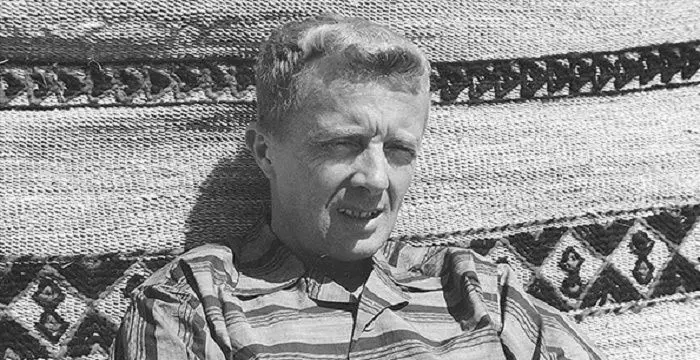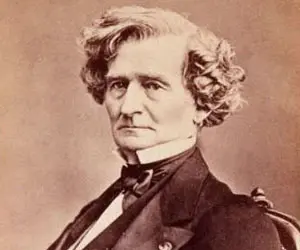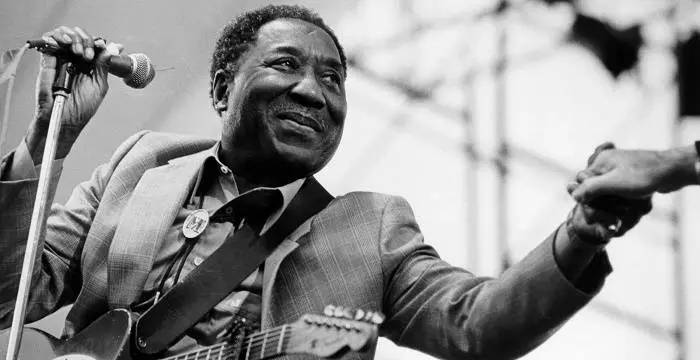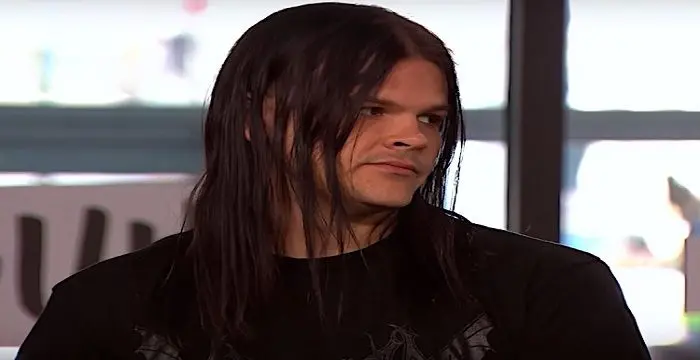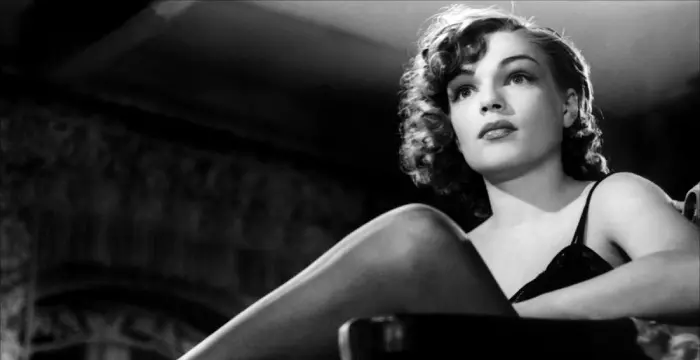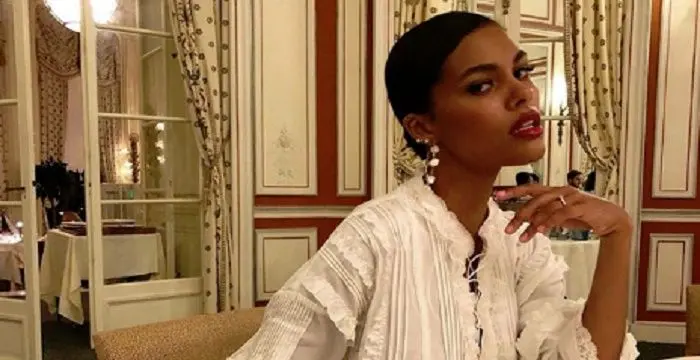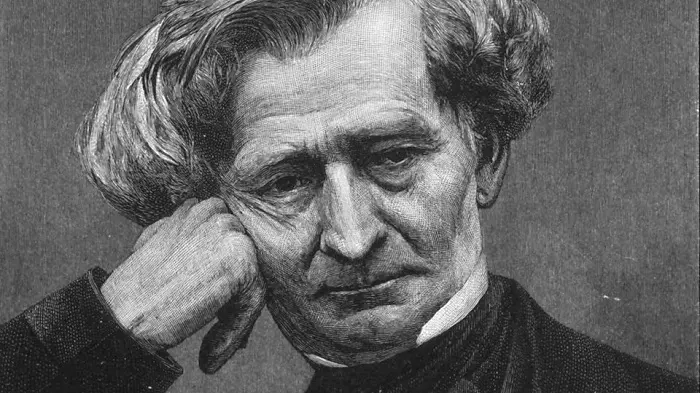
Hector Berlioz - Music Composer, Birthday and Family
Hector Berlioz's Personal Details
Hector Berlioz was a well-known French composer, remembered for his contribution to the development of Romanticism
| Information | Detail |
|---|---|
| Birthday | December 11, 1803 |
| Died on | March 8, 1869 |
| Nationality | French |
| Famous | Musicians, Music Composer |
| Spouses | Harriet Smithson, Mademoiselle Récio |
| Siblings | Adèle |
| Childrens | Louis Berlioz |
| Birth Place | La Côte-Saint-André |
| Gender | Male |
| Father | Louis-Joseph Berlioz |
| Mother | Marie-Antoinette |
| Sun Sign | Sagittarius |
| Born in | La Côte-Saint-André |
| Famous as | Music Composer |
| Died at Age | 65 |
// Famous Music Composer
Hans Zimmer
Hans Zimmer is a German film composer and record producer. This biography profiles his childhood, family, personal life, music career, achievements, and some interesting facts
Paul Bowles
Paul Bowles was an American writer, music composer, poet, translator and novelist. Check out this biography to know about his childhood, life, achievements, works & timeline.
Yanni
A music composer, pianist and keyboardist, Yanni is famously known for his performances at unusual venues like the Taj Mahal and Acropolis Theatre. To know more about his childhood, profile, timeline and career read on.
Hector Berlioz's photo
Who is Hector Berlioz?
One of the most original Romantic composers, fondly revered as the master of orchestration, Hector Berlioz's contribution to the world of music is unparalleled. Composer, critic, and conductor, this Romantic musician contributed greatly to the burgeoning romanticism. Not only that, he also enormously influenced the orchestral techniques of the era. In fact his contribution to Romantic music is so huge that he is often put in the same pedestal as that of writer Victor Hugo and painter Eugene Delacroix. Hector Berlioz made ground-breaking innovations in music, breaking away from the customary trends and introduced passion and emotion in the music. His findings in the realms of music have been so innovative that he is considered as the most original composers of his times. Most famous for his "Symphonie Fantastique", this musician has a string of feats to his name. For some of his works, he employed huge orchestral forces and several of his concerts were conducted with more than a thousand musicians. For a composer who was loved abroad and criticized at home, life was nothing less than a roller coaster ride. But despite everything, his genius stands tall when it comes to music.
// Famous Musicians
Ted Nugent
Ted Nugent is a hard rock musician known for his hits ‘Stranglehold’ and ‘Cat Scratch Fever’. This biography of Ted Nugent provides detailed information about his childhood, life, achievements, works & timeline.
Muddy Waters
Muddy Waters was a blues musician referred to as the 'father of modern Chicago blues.' Check out this biography to know about his childhood, family life, achievements and fun facts about him.
Travis Bacon
Travis Bacon is an American musician and actor, better known as the son of veteran actors Kevin Bacon and Kyra Sedgwick. Find more about his family, birthday, etc.
Childhood & Early Life
Hector Berlioz was born on 11 December 1803 at La Côte-Saint-André in the département of Isère. His father, Louis Berlioz, a physician, is believed to have introduced acupunctural techniques in Europe. His mother, Marie-Antoinette, was a devout Roman Catholic.
Hector was the oldest of his parents’ six children, three of whom died young. He was very close to his two surviving sisters, Nanci, younger to him by three years and Adèle, by eleven.
He started his education at the local seminary. Unfortunately, due to the on-going war with Great Britain and other European powers, it closed down in 1811. Thereafter, he continued his education under his father.
At the age of 10, he was briefly placed at a local school to study Latin. However his father soon took him out and began to supervise his entire education himself. However, he could not inspire in little Hector any love for classical languages. The boy detested learning the verses by heart.
Instead, he spent hours studying the atlas, spellbound at the complex patterns created by islands, straits and capes. He soon started wondering what kind of vegetation, climate or people those distant lands would have.
However, when in 1815, Hector was introduced to the works of La Fontaine and Virgil, those distant lands began to take a backseat. He now became more fascinated with the works of Virgil and began to translate them from their original Latin into French under his father’s supervision.
Also in 1815, he had his first taste of passion, falling madly in love with 18-year-old Estelle Fornier. In that very year in spring, while attending his first communion, he was mesmerized by the sound of church music. This was his first experience of music.
As a twelve-year-old, Hector Berlioz began to receive music lessons, first studying flute and then guitar. By 1816, he had learned to play flageolet and had also tried his hand in composition.
On 22 March 1821, he was made bachelier ès lettres at Grenoble and thereafter in October, he was sent to Paris to study medicine, a subject in which he had no interest. In spite of that, he continued attending classes on his father’s behest.
But later, as he witnessed a corpse being dissected, his indifference turned into outright disgust. Meanwhile, he had been frequenting the Paris Conservatoire library, attending the performances of ‘La Vestale’ and ‘Fernand Cortez’ at the Opéra. By the end of 1822, he had decided to devote his life to music.
In Paris
Accordingly from 1822, Hector Berlioz informally started studying music under Jean-François Le Sueur, the director of the Royal Chapel and professor at the Conservatoire. Here he learned to experiment in program music.
When in the spring of 1823, he made a trip to La Côte, his family tried to make him abandon music and concentrate on medicine. However, on returning to Paris, he resumed his study of music. During this period he wrote his first piece, ‘Estelle et Némorin’, which has now been lost.
Sometime now, he also wrote his first article on music. Written in the form of a letter, it was published in the journal ‘Le Corsaire’ in its 12 August 1823 issue.
On 12 January 1824, Berlioz was made a Bachelier ès sciences physiques. Despite receiving his degree, he continued to concentrate on music, completely abandoning medicine later in the same year. Also in 1824, he wrote, ‘Messe solennelle’, a setting of the Catholic Solemn Mass.
The piece was first performed at the Church of Saint-Roch in Paris on 10 July 1825. Later that year, he began to compose the opera ‘Les francs-juges’, which was completed the following year. Concurrently, in the winter of 1825, he composed ‘La Révolution grecque’ (La Scène héroïque).
In 1826, Hector Berlioz officially entered the Conservatory to study composition under Jean-François Le Sueur and Anton Reicha. His father now suspended his allowance. Yet he continued to study music, maintaining himself with odd jobs.
In 1827, he conducted the second performance of ‘Messe solennelle’ at Saint-Eustache on 22 November 1827. It was his first experience as a conductor. Encouraged, he presented his first orchestral concert on 26 May 1828 at the Conservatory.
Also in 1828, he submitted his cantata ‘Herminie’ at Prix de Rome and won the second prize. He had earlier submitted two more pieces; a fugue in 1826 and a cantata entitled ‘La Mort d’Orphée’ in 1827, but they failed to win any prize.
Since the first prize came with a five-year pension, which he badly needed, he kept on trying. Finally, he won the prize in 1830 with his fourth cantata, entitled ‘Sardanapale’.
This was also the year, when he wrote and composed ‘Symphonie fantastique.’ By that time, he had established himself in the music world of Paris with his concerts at the Conservatory and this work further enhanced his fame.
Unfortunately, a clause in the Prix de Rome required the winner to study in Rome for two years. Therefore, just as he was gaining recognition in Paris he had to leave the city.
In Italy
Hector Berlioz left Paris on 30 December 1830, arriving in Rome in March 1831. There he put up at the French Academy in the Villa Medici. However, he found the city distasteful and therefore, took every opportunity to go out of the city, enjoying the country side.
While in Rome, he received news that his fiancée had married somebody else. Enraged, he set out to kill her but sanity prevailed as he reached Nice. While staying there, he composed the overture ‘Le roi Lear’ and started working on the overture ‘Rob Roy’, and ‘Le retour à la vie’, later called ‘Lélio’.
Thereafter, he travelled to Pompeii, Naples, Milan, Tivoli, Florence, Turin and Genoa. These visits provided him with rich experiences, which influenced his later works. Finally he returned to Paris in November, 1832.
Return to Paris
Alongside composing, he also became famous as a conductor. On 9 December 1832, he gave a concert of ‘Symphonie Fantastique’ and its sequel, ‘Lélio’ with many of the city’s top intellectuals attending it. It was followed by many others.
The period that followed was highly productive for Berlioz and many of his famous pieces were written during this time. Among them were ‘Harold en Italie’ (1834), ‘Benvenuto Cellini’ (1836) ‘Grande messe des morts’ (1837), and ‘Roméo et Juliette’ (1839).
However, such success did not translate into financial gain. Berlioz still had to depend on music criticism as well as other writing works for his sustention. As a way out, he decided to go on musical tours.
From 1842, he started taking extensive foreign tours. Concurrently, he also gained recognition as a writer and in January 1844, had ‘Grand traité d’instrumentation et d’orchestration modernes’ published.
In November 1847, after a four-month visit to Russia, he embarked on a seven-month tour of England, where he was appointed conductor of the Theatre Royal Drury Lane. It was also the time, when he started writing his ‘Mémoires.’
Later Years
In 1850, Hector Berlioz became head librarian at the Paris Conservatoire and with that his financial woes came to an end. It was the only official post he would ever hold. Concurrently, he kept on writing new compositions and also continued with his tours, where he was enthusiastically received.
From 1856 to 1858, he worked on one of his masterpieces, an opera, titled ‘Les Troyens’, based on Virgil's epic ‘Aeneid.’ He wanted to stage it on Paris Opera but was rejected because it was too long. Therefore, it was first performed in 1863 at the Theâtre Lyrique in a drastically shortened form.
Meanwhile in 1861 he started work on his last opera, ‘Béatrice et Bénédict’, completing it in the following year. Based on Shakespeare's ‘Much Ado about Nothing’, the opera, conducted by Berlioz, had its first performance at a festival at Baden-Baden in August 1862.
In 1863 Berlioz published his last signed article for the ‘Journal des débats’ and by 1865, he had 1200 copies of his ‘Mémoires’ printed; they were mostly kept away to be published after his death. Meanwhile in 1864 Berlioz was made Officier de la Légion d'honneur.
At the same time, he continued with his musical tour, visiting Vienna in 1866 and conducting the first complete performance of ‘La Damnation de Faust’ there on 16 December.
Then in February 1867, he visited Cologne and in November he went to Russia, from where he returned on 17 February 1868. His last trip was made to Grenoble; he went there in August to preside over a choral competition.
Major Works
Hector Berlioz is best remembered for his composition ‘Grande messe des morts.’ It derives its text from the traditional Latin Requiem Mass and has duration of about ninety minutes. It consists of ten movements. It and showcases a grand orchestration of woodwind and brass instruments.
He is also known for his earlier composition ‘Symphonie fantastique.’ Considered an important piece of the early Romantic period, this program symphony is famous for its dream-like nature.
He is also equally remembered for his book, ‘Grand traité d’instrumentation et d’orchestration modernes.’ Abbreviated in English as ‘Treatise on Instrumentation’, it is a technical study on Western musical instruments and contributes significantly to the modern orchestra.
Personal Life & Legacy
Hector Berlioz fell in love for the first time with Estelle Fornier, six years his senior, at the age of twelve. However, unlike other early crushes, he carried the flame till the end of his life.
On 11 September 1827, while attending a production by a traveling English theatre company, he saw Harriet Smithson, an Irish-born actress, playing Ophelia. He was immediately infatuated with her and began to flood her with love letters. Harriet did not respond.
Next in 1830, he started a relationship with Camille (Marie) Moke, a talented pianist, who got married to a wealthier person while he was away in Rome.
On his return, he met Harriet Smithson in person. Although he did not know enough English and she did not know French, the two got married on 3 October 1833. Their only child, Louis Berlioz was born on 14 August 1834.
Soon Berlioz realized that, it was easier to admire Harriet from afar than to live with her. She was jealous of his success and the two had frequent outbursts. Subsequently, she moved out of their matrimonial house. However, Berlioz financially supported her till her death.
Meanwhile, Berlioz had developed a relationship with Marie Recio, a singer, and married her on 19 October 1854. She died from a stroke in 1862.
Soon after that, he developed a relationship with 24-year-old Amélie. However, she too died within two years. His only son, Louis, who later grew up to be the Commander at the merchant navy, also died on 5 June 1867 from yellow fever. The deaths left him devastated.
Towards the end of his life Berlioz was inflicted with intestinal diseases, which often caused acute pain. He died on 8 March 1869 at his Paris home at 12:30 in the afternoon. His funeral was held at Église de la Trinité on 11 March, and he was buried in Montmartre Cemetery.
Trivia
Sometime in the 1850s, Berlioz wrote ‘Shepherd's Farewell’ under the pen name of Pierre Ducré and had it performed in two concerts. His critics praised it highly, some of them going to the extent of declaring that Berlioz should learn from it while others said, he would never be able to write something like it.
// Famous Sagittarius Celebrities peoples
Billie Eilish
Billie Eilish Pirate Baird O’Connell is an American singer and songwriter. Check out this biography to know about her childhood, family, personal life, birthday, etc.
Jacelyn Reeves
Jacelyn Reeves is a former flight attendant who once had a fling with Clint Eastwood. Check out this biography to know about her birthday, childhood, family life, achievements and fun facts about her.
Edmund Kemper
Edmund Kemper is a convicted serial killer from America who murdered ten people. Check out this biography to know about his childhood, life, crimes and other facts about him.
Hector Berlioz's awards
| Year | Name | Award |
|---|---|---|
Other | ||
| 0 | 1831 - Prix de Rome | |
Hector Berlioz biography timelines
- // 11th Dec 1803Hector Berlioz was born on 11 December 1803 at La Côte-Saint-André in the département of Isère. His father, Louis Berlioz, a physician, is believed to have introduced acupunctural techniques in Europe. His mother, Marie-Antoinette, was a devout Roman Catholic.
- // 1811He started his education at the local seminary. Unfortunately, due to the on-going war with Great Britain and other European powers, it closed down in 1811. Thereafter, he continued his education under his father.
- // 1815However, when in 1815, Hector was introduced to the works of La Fontaine and Virgil, those distant lands began to take a backseat. He now became more fascinated with the works of Virgil and began to translate them from their original Latin into French under his father’s supervision.
- // 1815Also in 1815, he had his first taste of passion, falling madly in love with 18-year-old Estelle Fornier. In that very year in spring, while attending his first communion, he was mesmerized by the sound of church music. This was his first experience of music.
- // 1816As a twelve-year-old, Hector Berlioz began to receive music lessons, first studying flute and then guitar. By 1816, he had learned to play flageolet and had also tried his hand in composition.
- // 22nd Mar 1821On 22 March 1821, he was made bachelier ès lettres at Grenoble and thereafter in October, he was sent to Paris to study medicine, a subject in which he had no interest. In spite of that, he continued attending classes on his father’s behest.
- // 1822But later, as he witnessed a corpse being dissected, his indifference turned into outright disgust. Meanwhile, he had been frequenting the Paris Conservatoire library, attending the performances of ‘La Vestale’ and ‘Fernand Cortez’ at the Opéra. By the end of 1822, he had decided to devote his life to music.
- // 1822Accordingly from 1822, Hector Berlioz informally started studying music under Jean-François Le Sueur, the director of the Royal Chapel and professor at the Conservatoire. Here he learned to experiment in program music.
- // 1823When in the spring of 1823, he made a trip to La Côte, his family tried to make him abandon music and concentrate on medicine. However, on returning to Paris, he resumed his study of music. During this period he wrote his first piece, ‘Estelle et Némorin’, which has now been lost.
- // 12th Aug 1823Sometime now, he also wrote his first article on music. Written in the form of a letter, it was published in the journal ‘Le Corsaire’ in its 12 August 1823 issue.
- // 12th Jan 1824On 12 January 1824, Berlioz was made a Bachelier ès sciences physiques. Despite receiving his degree, he continued to concentrate on music, completely abandoning medicine later in the same year. Also in 1824, he wrote, ‘Messe solennelle’, a setting of the Catholic Solemn Mass.
- // 10th Jul 1825The piece was first performed at the Church of Saint-Roch in Paris on 10 July 1825. Later that year, he began to compose the opera ‘Les francs-juges’, which was completed the following year. Concurrently, in the winter of 1825, he composed ‘La Révolution grecque’ (La Scène héroïque).
- // 1826In 1826, Hector Berlioz officially entered the Conservatory to study composition under Jean-François Le Sueur and Anton Reicha. His father now suspended his allowance. Yet he continued to study music, maintaining himself with odd jobs.
- // 1827In 1827, he conducted the second performance of ‘Messe solennelle’ at Saint-Eustache on 22 November 1827. It was his first experience as a conductor. Encouraged, he presented his first orchestral concert on 26 May 1828 at the Conservatory.
- // 11th Sep 1827On 11 September 1827, while attending a production by a traveling English theatre company, he saw Harriet Smithson, an Irish-born actress, playing Ophelia. He was immediately infatuated with her and began to flood her with love letters. Harriet did not respond.
- // 1828Also in 1828, he submitted his cantata ‘Herminie’ at Prix de Rome and won the second prize. He had earlier submitted two more pieces; a fugue in 1826 and a cantata entitled ‘La Mort d’Orphée’ in 1827, but they failed to win any prize.
- // 1830Since the first prize came with a five-year pension, which he badly needed, he kept on trying. Finally, he won the prize in 1830 with his fourth cantata, entitled ‘Sardanapale’.
- // 1830Next in 1830, he started a relationship with Camille (Marie) Moke, a talented pianist, who got married to a wealthier person while he was away in Rome.
- // 30th Dec 1830 To Mar 1831Hector Berlioz left Paris on 30 December 1830, arriving in Rome in March 1831. There he put up at the French Academy in the Villa Medici. However, he found the city distasteful and therefore, took every opportunity to go out of the city, enjoying the country side.
- // 1832Thereafter, he travelled to Pompeii, Naples, Milan, Tivoli, Florence, Turin and Genoa. These visits provided him with rich experiences, which influenced his later works. Finally he returned to Paris in November, 1832.
- // 9th Dec 1832Alongside composing, he also became famous as a conductor. On 9 December 1832, he gave a concert of ‘Symphonie Fantastique’ and its sequel, ‘Lélio’ with many of the city’s top intellectuals attending it. It was followed by many others.
- // 3rd Oct 1833 To 14th Aug 1834On his return, he met Harriet Smithson in person. Although he did not know enough English and she did not know French, the two got married on 3 October 1833. Their only child, Louis Berlioz was born on 14 August 1834.
- // 1842 To Jan 1844From 1842, he started taking extensive foreign tours. Concurrently, he also gained recognition as a writer and in January 1844, had ‘Grand traité d’instrumentation et d’orchestration modernes’ published.
- // Nov 1847In November 1847, after a four-month visit to Russia, he embarked on a seven-month tour of England, where he was appointed conductor of the Theatre Royal Drury Lane. It was also the time, when he started writing his ‘Mémoires.’
- // 1850In 1850, Hector Berlioz became head librarian at the Paris Conservatoire and with that his financial woes came to an end. It was the only official post he would ever hold. Concurrently, he kept on writing new compositions and also continued with his tours, where he was enthusiastically received.
- // 19th Oct 1854 To 1862Meanwhile, Berlioz had developed a relationship with Marie Recio, a singer, and married her on 19 October 1854. She died from a stroke in 1862.
- // 1861 To Aug 1862Meanwhile in 1861 he started work on his last opera, ‘Béatrice et Bénédict’, completing it in the following year. Based on Shakespeare's ‘Much Ado about Nothing’, the opera, conducted by Berlioz, had its first performance at a festival at Baden-Baden in August 1862.
- // 1866At the same time, he continued with his musical tour, visiting Vienna in 1866 and conducting the first complete performance of ‘La Damnation de Faust’ there on 16 December.
- // Feb 1867 To 17th Feb 1868Then in February 1867, he visited Cologne and in November he went to Russia, from where he returned on 17 February 1868. His last trip was made to Grenoble; he went there in August to preside over a choral competition.
- // 5th Jun 1867Soon after that, he developed a relationship with 24-year-old Amélie. However, she too died within two years. His only son, Louis, who later grew up to be the Commander at the merchant navy, also died on 5 June 1867 from yellow fever. The deaths left him devastated.
- // 8th Mar 1869Towards the end of his life Berlioz was inflicted with intestinal diseases, which often caused acute pain. He died on 8 March 1869 at his Paris home at 12:30 in the afternoon. His funeral was held at Église de la Trinité on 11 March, and he was buried in Montmartre Cemetery.
// Famous French peoples
Simone Signoret
Simone Signoret was a French actress who became the first French person to win an Academy Award. Check out this biography to know about her childhood, family life, achievements and other facts related to her life.
Jade Weber
Scroll down this bio to find out everything about French model Jade Weber. Be it fun facts, birthday, trivia or details of her personal and family life, you’ll find everything here.
Micheline Roquebrune
Micheline Roquebrune is a petite Moroccan-French painter best known as the third wife the legendary Scottish actor Sir Sean Connery. Check out this biography to know about her birthday, childhood, family life, achievements and fun facts about her.
Alex Lange
Alex Lange is a French-South African model, who is quite popular on Instagram. Check out this biography to know about his childhood, family life, achievements and fun facts about him.
Tina Kunakey
Tina Kunakey Di Vita is a model and wife of the French actor Vincent Cassel. Check out this biography to know about her birthday, childhood, family life, achievements and fun facts about her.
Jeanne Calment
Jeanne Calment was a French supercentenarian who had the longest confirmed lifespan in human history. Check out this biography to know about her childhood, family, personal life, death, etc.
Hector Berlioz's FAQ
What is Hector Berlioz birthday?
Hector Berlioz was born at 1803-12-11
When was Hector Berlioz died?
Hector Berlioz was died at 1869-03-08
Where was Hector Berlioz died?
Hector Berlioz was died in Paris
Which age was Hector Berlioz died?
Hector Berlioz was died at age 65
Where is Hector Berlioz's birth place?
Hector Berlioz was born in La Côte-Saint-André
What is Hector Berlioz nationalities?
Hector Berlioz's nationalities is French
Who is Hector Berlioz spouses?
Hector Berlioz's spouses is Harriet Smithson, Mademoiselle Récio
Who is Hector Berlioz siblings?
Hector Berlioz's siblings is Adèle
Who is Hector Berlioz childrens?
Hector Berlioz's childrens is Louis Berlioz
Who is Hector Berlioz's father?
Hector Berlioz's father is Louis-Joseph Berlioz
Who is Hector Berlioz's mother?
Hector Berlioz's mother is Marie-Antoinette
What is Hector Berlioz's sun sign?
Hector Berlioz is Sagittarius
How famous is Hector Berlioz?
Hector Berlioz is famouse as Music Composer

